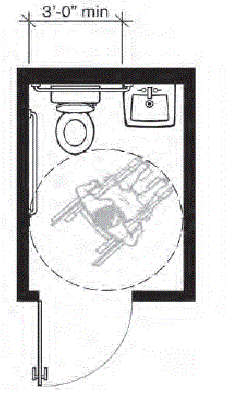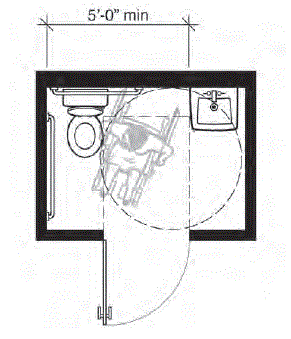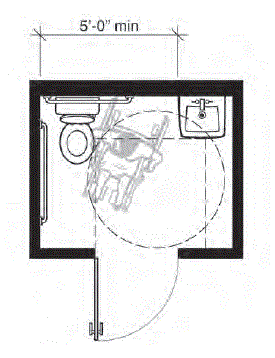Comparison of Single-User Toilet Room Layouts: 1A, 1B, and 1C
|
1991 Standards  Plan-1A: 1991 Standards Minimum with Out-Swinging Door 5’-0" x 7’-3" • 36.25 Square Feet |
| This plan shows a typical example of a single-user toilet room that meets the minimum requirements of the 1991 Standards. The size of this space is determined by the minimum width required for the water closet and lavatory between the side walls, the minimum wheelchair turning space, and the space required for the out-swinging door. A lavatory with knee space can overlap the clear floor space required for the water closet provided that at least 36 inches of clearance is maintained between the side wall next to the water closet and the lavatory (see section 4.16.2 and Fig. 28 of the 1991 Standards). A wheelchair turning space meeting section 4.2.3 of the 1991 Standards must be provided. The size of this room requires that the entry door swing out. The room would be larger if the door were in-swinging. |
|
2010 Standards  Plan-1B: 2010 Standards Minimum with Out-Swinging Door 7’-0" x 5’-0" • 35.00 Square Feet |
|
This plan shows a typical example of a single-user toilet room that meets the minimum requirements of the 2010 Standards. Features include: five-foot minimum width between the side wall of the water closet and the lavatory; 60-inch minimum circular wheelchair turning space; and 36-inch by 48-inch clear maneuvering space for the out-swinging entry door. Section 604.3.1 of the 2010 Standards requires a floor clearance at a water closet that is a minimum of 60 inches wide by 56 inches deep regardless of approach. Section 604.3.2 prohibits any other plumbing fixtures from being located in this clear space, except in residential dwelling units. The 2010 Standards, at section 304.3, allows the turning space to extend into toe and knee space provided beneath fixtures and other elements. Required maneuvering space for the entry door (inside the room) must be clear of all fixtures. If the door had both a closer and latch, section 404.2.4.1 and Figure 404.2.4.1(c) require additional space on the latch side. This layout is three point five percent (3.5%) smaller than the accompanying Plan−1A: 1991 Standards Minimum with Out-Swinging Door example. |
|
2010 Standards  Plan-1C: 2010 Standards Minimum with Out-Swinging Door (entry door has both closer and latch) |
|
This plan shows the same typical features of a single-user toilet room that meets the minimum requirements of the 2010 Standards as Plan−1B does except the entry door has both a closer and latch. Because the door has both a closer and latch, a minimum additional foot of maneuvering space is required on the latch side (see section 404.2.4.1 and Figure 404.2.4.1(c) of the 2010 Standards). This layout is six point two percent (6.2%) larger than the accompanying Plan−1A: 1991 Standards Minimum with Out-Swinging Door example. |

User Comments/Questions
Add Comment/Question